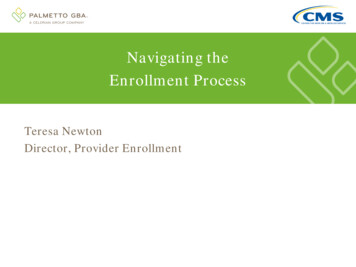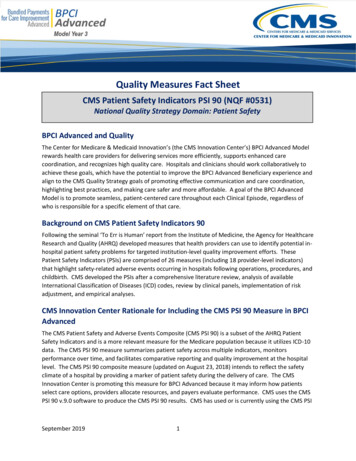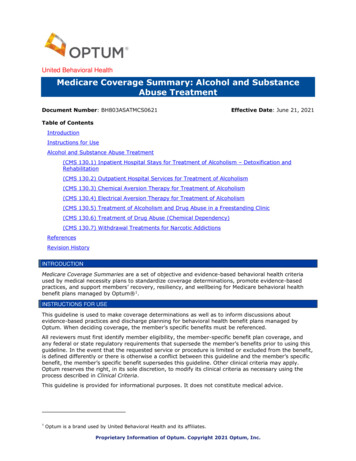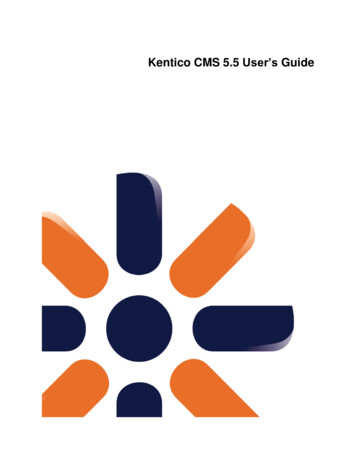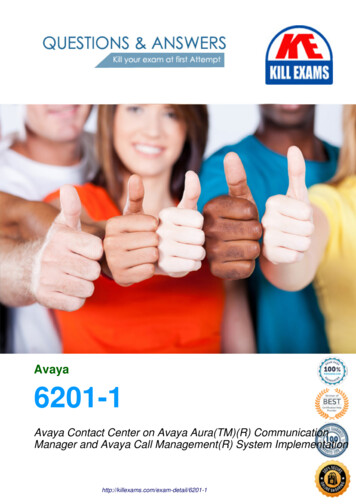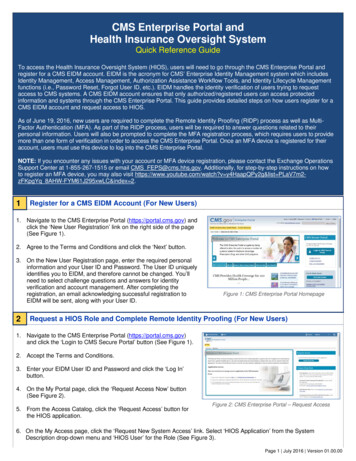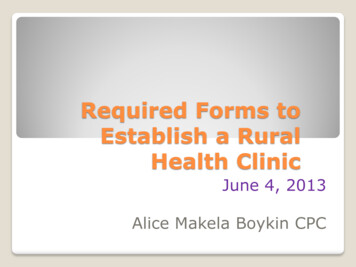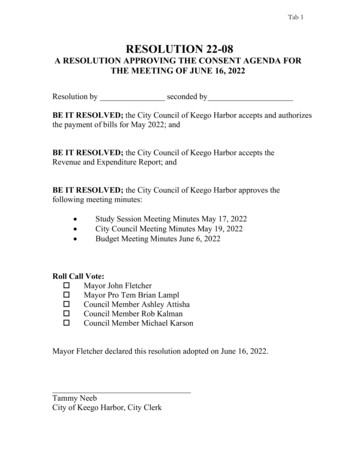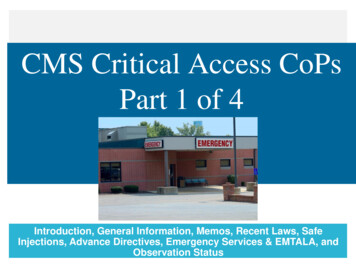
Transcription
CMS Critical Access CoPsPart 1 of 4Introduction, General Information, Memos, Recent Laws, SafeInjections, Advance Directives, Emergency Services & EMTALA, andObservation Status
Speaker Lena Browning MHA, BSN, RNC-NIC, CSHA Consultant, Nash HealthcareConsulting 270-499-0843 LBrowning@Nashhc.com Email questions to CMS:Critical Access Hospitals: qsog CAH@cms.hhs.gov.Acute hospitals: qsog hospital@cms.hhs.gov.22
Introduction3
Why We are Here Today4
Mandatory Compliance Hospitals that participate inMedicare or Medicaid Must meet the Conditions ofParticipation (COPs) For all patients in the facilities “Deemed Status” – accredited bythe Joint Commission (TJC),HFAP, CIHQ, or DNV Healthcare5
Deficiency/Citation .html6
Deficiency Citation Reports7
Deficiencies by Tag Number8
CAH Problematic Standards Orders/entries datedand timed Verbal orders Cluttered hallways &other Life Safety Codeissues H&Ps EMTALA Medications Meeting nutritionneeds of patients Healthcare servicesper P&P Timing ofmedications Documentationreflecting nursingprocess9
CAH Problematic Standards Equipment andsupplies used in lifesaving procedure Informed consent Hand Hygiene &Gloving Legibility Restraint & Seclusionfor Acute hospitals Safe Injectionpractices Privacy & whiteboard No orders Suicide precautions Infection control10
Immediate Jeopardy11
Search for Hospital Inspections12
Search for Hospital Survey Reports13
Read the Report14
CAH General Resources15
AHA Websitewww.aha.org/advocacy/small-or-rural16
Rural Health Information Hub thinfo.org/17
CMS Updated Website www.cms.gov18
CMS Surveyor TrainingWebsite19
Surveyor TrainingClick on Cataloghttps://qsep.cms.gov/welcome.aspx20
Alphabetical Lists of Training21
Select CAH Basic Training 24 nformation.aspx?cid 0CMSCAHBasic CEU ONL22
Introduction Intothe Conditions of Participation23
The Conditions of Participation (CoPs) Start in the Federal Register CMS publishes Interpretive Guidelines Some include survey procedures Different from “worksheets”24
Subscribe to the Federal GPOOFR/subscriber/new25
CMS Hospital CoP Manual stoc.pdf.26
CMS CoP Manual27
State Operation Manual – Critical Access28
CMS Survey -Memos-to-States-and-Regions29
New Tag xlsx30
CMS Hospital Improvement Rule, DischargePlanning and Recent Changes
Introduction Final regulations published September 2019,effective November 2019 Addressed Emergency preparedness Made changes to swing bed requirements Updated discharge planning standards Rewrote QAPI requirements Changes to infection control Implementation of Antibiotic Stewardship Program32
Improvement Rule – cont’d Established staffing and staff responsibility Quality and appropriateness Diagnosis by PA, NP, or CNS by MD/DO under contract withthe CAH Diagnosis and treatment by MD/DO is evaluated– QIO– Hospital that is a member of the network or– Qualified individual identified in the state rural health plan Includes a section to evaluate telemedicine providers33
Improvement Rule – cont’d Provision of services P&P - nutritional needs being met Diet order by physician or provider Can C&P dietician Policies reviewed every two years vs. annually34
Manual Changes Changes/manual for 10 Bed Behavioral Health orRehab, hospitals and CAHs– Interpretive guidelines and survey procedures pending– Tag numbers 1400, 1404, 1406, 1408, 1410, 1412,1417, 1420, 1422, 1425, and 1430– Similar to Appendix A with a few minor exceptions35
February 2020 Updates CAHs Deleted multiple tags number Renumbered all the tag numbers in 2020 Revises table of content to include special requirement forCAH of LTC services Revised the survey protocol– Grant immediate access or can terminate Medicare– Cannot refuse to permit copying of records or information by thesurveyor36
2020 Updates continued Other changes: No advanced notice of survey Will assess compliance with all areas under CCN Surveyor must complete basic surveyor course Revised swing bed section: Eligibility, SNF service, admission, transfer and discharge Freedom from abuse, neglect and exploitation Services directed by qualified professional Care plan and discharge planning37
2020 Updates – continued New standard 410 on nutrition Will look at telemedicine contract Will not withhold areas of concern until the end Surveyor cannot touch or examine patients Surveyor may make copies of some of the EHRs38
2020 Updates – continued Surveyor questions to the staff: What happens if the computer system goes down? How do you register a patient, transfer or admit? How do you order or get lab results? Will determine if corrective actions “fix” the deficientpractice If record session – surveyor must be given a copy39
2020 Updates – continued Will not delay survey for staff to arrive Make sure surveyors have access to copiers andprinters Surveyors will not provide the hospital with a list ofthe records reviewed or patients, staff or visitorsthat they talked to Staff can accompany surveyors Cannot provide answers or interject information40
CMS Memo on Texting41
CMS Memo on Texting In medical record sections Tags 438, 441, and 467 RULE: texting of orders not allowed Patient information: System must be secure, encrypted, and minimizeprivacy/confidentially risks Text consults, emergency notification etc. CPOE is the preferred way to enter an order Questions to Marie.Vasbinder1@cms.hhs.gov42
43
CMS Memo on LigatureRisks44
Memo CMS clarified ligature risk policy In App A manual CAH should carefully review Want a safe environment to prevent patients fromhanging themselves or strangulation Focuses on the care and safety of behavioral health patientand staff No waivers for ligature risk deficiencies If cited must provide monthly progress reports45
Draft Guidance CMS published draft of the clarification of ligaturerisk interpretive guidelines Revised to provide clarity to the surveyors andhospitals Amends how to request an extension for adeficiency for psych hospitals and units46
CMS Memo on Safe InjectionPractices47
Question Our facility has experienced a shortage ofmedications over the past year Yes No Prefer not to answer Not sure48
Memo on Safe Injection Practices Discussed use of single dose medication Prevent healthcare associated infections (HAI) Notes new exception - important especially inmedications shortages General rule: single dose vial (SDV) can only be usedon one patient Will allow on multiple patients if - prepared bypharmacist under laminar hood following USP 797guidelines49
Safe Injection Practices – cont’d Entries for repackaging must be completed within 6hours One exception when SDV can be used on multiplepatients Can be cited under infection control standards sincemust provide sanitary environment50
Safe Injection Practices – cont’d Bottom line: cannot use a single dose vial onmultiple patients Must follow nationally recognized standards of care CDC guidelines has 10 practices SDV typically lack an antimicrobial preservative The vials must have a beyond use date (BUD) andstorage conditions on the label If use off-site vendor or compounding facility Ask for evidence have adhered to 797 standards51
Single vs. Multi Dose Vials If make it in a single dose vial - need to buy it in asingle dose vial If only multi-dose – use as single dose vial Do not take multi-dose vial into patient room or intoOR In OR treat as a single dose vial and discard Mark multi-dose vial expires in 28 days unless sooner bymanufacturer Clean off lid even if new vial for 10-15 seconds and let dry52
Not All Vials Are Created Equal53
54
ISMP IV Push MedicationGuidelines55
IV Push Medicine GuidelinesRemember; CMS says you have to followstandards of care and specifically mentions theISMP so surveyor can site you if you do notfollow this.56
IV Push Medications Guidelines Provide IV push medications in a ready toadminister form Use only commercially available or pharmacyprepared prefilled syringes of IV solutions to flushvascular access devices If available in a single dose vial – buy in single dosevial Use aseptic technique when preparing andadministering IV medication Includes hand hygiene before and after administration57
IV Push Guidelines – cont’d Disinfect the diaphragm If use glass ampule – use filter needle unless thespecific drug precludes such Medication should only be diluted when: Recommended by the manufacturer or Per evidence-based practice Approved hospital policies58
IV Push Guidelines – cont’d If IV require dilution Performed in a clean, uncluttered, and separate location Should not be withdrawn from a commerciallycartridge type syringe into another syringe foradministration Medication not drawn up into prefilled 0.9% salineflushes59
IV Push Guidelines – cont’d Combination of more than one medication is seldomnecessary Never use IV solution/mini bags as a common IVflush source or dilutant Label syringes Unless prepared and immediately given with no break Administer IV push medication at manufacturerrecommended rate Or supported by evidenced-based practices60
ISMP Subq Insulin Insulin is a high alert medication Associated with more medication errors than anyother drug 16% of all medication errors Leading cause of harmful errors (24%)61
f62
CMS WorksheetsSafe Injection Practices
Hospital Worksheets CMS had 3 worksheets for surveys – part of pilotprograms Discharge planning Infection control QAPI (performance improvement)64
Infection Control Worksheet65
Discharge Planning Worksheet66
QAPI Worksheet67
Injection Practices & Sharps Safety Injections prepared using aseptic technique in areacleaned and free of blood and bodily fluids Rubber septum disinfected with alcohol before piercing Single dose vials, IV bags/connectors used on only onepatient Multidose vials dated when opened and discarded in 28days unless shorter time by manufacturer Expiration date is clear as per P&P If multidose vial in patient care area used on only onepatient68
Other Survey Memos onInfection Control69
Legionnaires’ Disease (LD) Can cause type of pneumonia called LD Grows in hospital water systems that arecontinuously wet Check waterborne pathogen compliance Surveyors will likely pay more attention to it Conduct a facility risk assessment70
CDC Resources Legionnaires’ Disease71
CDC Water Management f72
Infection Control Breaches When breaches warrant referral to the public healthauthorities This includes a finding by the state agency or anaccreditation organization TJC, DNV GL Healthcare, CIHQ, or HFAP State authority – state epidemiologist or State HAIPrevention Coordinator73
Needles – Syringes – Lancing Device Using same needle Using same syringe, pen or injection device Re-using a needle or syringe To re-enter a medication container Then using contents from that medication container foranother individual Using the same lancing/fingerstick device Even if the lancet is changed74
Memo on Insulin Pens Used on one patient only Insulin pens were used on more than one patient Like sharing needles Every patient must have their own insulin pen Insulin pens must be marked with the patient’sname75
Insulin Pens – cont’d Blood regurgitates into cartridge after injection Needs policy and procedure Educate staff on safe use of insulin pens CDC issues reminder on same and has free flier (see Appendix)76
Pen Posters and Brochures n-pen-safety77
CDC Vaccine Storage and Handling Toolkit Do not store vaccines in dorm like refrigerators Temperature revised to range between 36 and 46degrees (previously 35-46 degrees F) State may also have specific requirements and monitordaily Use a medical (biological) refrigerator Monitors temperature and set at mid range (40 degrees) E-mail specific questions to CDC: NIPInfo@cdc.gov78
CMS CAH Hospital CoPs79
CMS Hospital CoPs - Generally Appendix W, Starts at tag C-800, Tag numbers renumbered in 2020 and reflected in Feb2020 manual update Interpretive guidelines updated frequently Manual includes swing bed regulation Interpretive guidelines and Survey Procedures inAppendix PP – LTC manual – F standards80
Gap Analysis Take each section and document how you comply Include tag numbers in policies Include policies Highlight section that corresponds to the required P&P inthe CoP Have one person in charge To keep up with changes and who Knows what to do if CMS shows up survey81
Rehab or Behavioral Health Unit CAH can have up to a ten-bed rehab or psych(behavioral health) unit Surveyed under Appendix A program Psych bed standards were in Appendix AA butmoved to Appendix A now Tag number 1600 to 172682
Manual for 10 Bed Behavioral or Rehab83
TJC Revised Requirements TJC or the Joint Commission made many changes Bring standards into closer alignment with CMS Having less differences is helpful to hospitals Have for hospitals that use them to get deemedstatus (DS) or payment for M/M patients Will specify “DS” after the standard84
General Information Can make copies of things Have surveyor make you a copy also Ask surveyor not to make copy of peer review material– Abstract out what is needed85
Resources to Keep Handy Appendix W Hospital CoPs (“C”) If have “distinct” rehab or behavioral health unit will needAppendix A Survey protocol and module Q- Immediate jeopardy V-EMTALA, Z-emergency preparedness W-Hospital swing beds-if you have these B- Home health I-Life safety code86
Survey Procedure The interpretive guidelines provide instructions tothe surveyors Have survey procedure instructions Will ask patients if the hospital told them about theirrights Deficiency citation show how the entity failed tocomply with regulatory requirements87
Survey Protocol Off-survey preparation Entrance activities Information gathering/investigation Preliminary decision making and analysis of finding Exit conference Post survey activities88
Question Our facility has seen an increase in the utilization ofour Swing Beds due to COVID. Yes No Not sure/Do not know89
Swing Beds
Swing Bed Module Will survey under CAH swing-bed requirements Reimbursement is for Skilled Nursing care asopposed to Acute Care Term is for reimbursement Not geographical91
Swing Bed Module In acute care status one day – Swing bed status thenext day 3-day qualifying inpatient stay required Not observation Give Notice letter to outpatient observation patients(MOON Form) Swing-bed survey requirements are in 42 CFR 48392
Swing Bed Counts “25 Bed” Will count: Do not count: Inpatient beds Observation beds Birthing beds – ifremain after giving birth Surgery, PACU L&D, newborn nursery ED stretchers Will do open recordreview on ALL swingbed patients Sleep lab beds Exam tables Medicare rehab/psychedistinct units93
Basic Information & New Tags Start with tag 800 – “C” CAH CoPs Tag 800 Basis and Scope Conditions to meet to be a CAH Tag 802 Rural Health Network At least one hospital the state designated as a CAH andone that provides acute care Entered into an agreement for patient referral and transfer Use of communication systems such as telemetry andsharing of patient data Transport among members94
Basic Information – cont’d Each CAH has an agreement for C&P and QAPIwith one of the following: (Tag 802 continued) One hospital that is a member of the network whenapplicable One QIO or equivalent entity or One other appropriate and qualified entity identified in theState rural health care plan Personnel Qualifications - qualifications of a CNS,NP, PA (804) Remember the state defines the scope of practice CMS will enforce the state law and scope of practice95
Basic Information – cont’d Tag 808 – designation and certification of CAHs States has a Medicare rural hospital flex programand can designate a CAH meeting the CoPs Criteria for certification Hospital has been surveyed by the state agency Is in compliance with the CAH CoPs96
Compliance with Laws810 Standard: CAH must comply with all federal, state,and local laws Surveyor may interview CEO to determine May refer non-compliance to proper agency withjurisdiction such as OSHA or OCR TB, blood borne pathogen, universal precautions, or EPA(hazardous material or waste issues)97
Advance Directives812 Standard: CAH must comply with federal laws andregulations related to the health and safety ofpatients PSDA or Patient Self Determination Act is a federal law Right to make advance directives Staff must comply with their advance directives Right to refuse treatment May have a DPOA or a support person/patientadvocate98
Advance Directives – cont’d May use to designate a support person - to exercisevisitation rights If patient incapacitated and DPOA – must giveinformation to make informed decisions and consentfor the patient CAH must also seek the consent of the patient’srepresentative when informed consent is required fora care decision99
Advance Directives – cont’d Must provide information to the competent patientwhen admitted Should consider giving to outpatient as applicable ED Observation Same Day surgery Document in medical record If incapacitated, give to family or surrogate Has conscience objector clause100
Advance Directives – cont’d Cannot require one Must make sure staff is educated on the P&P Includes the right to make a psychiatric advancedirective or mental health declaration Give consideration even if no state specific law Must provide community education101
Physician Ownership Disclosures*812 Must disclose if physician owns the hospital Includes ownership by immediate family member and mustbe in writing If physician owners do not refer to the hospital – must signattestation to this effect Physicians must also disclose to patients who theyrefer This must be as a condition for getting MS privileges Disclose on public websites for advertising for thehospital – is owned/invested in by physicians102
Disclosures - continued Disclose in writing if a physician is not on thepremises 24 hours a day for emergencies Sign acknowledgement if patient admitted Need not to give individual notices to patients in theemergency department (ED) A notice must be posted in the ED in a conspicuous place It must cover how the hospital will meet the needs of thepatient in an emergency If separate location and no physician must give notice103
Compliance with Laws/Licensure Standard: Patient care services must be providedwith in accordance with laws (814) Ensure delegation as allowed by law Ensure practicing according to scope of practice, such asNP, CNS, or PA Standard: Hospital must be licensed (816) Personnel must be licensed or certified if required by state Will review sample of personnel files104
Laws/Licensure – cont’d Ensure staff meet all state laws for certification,qualification, training and education requirements Can verify licensure on the board of nursing website The surveyor to check and make sure licensureinformation is up to date Will look at policies on certification and licensure105
Status/Location822 Tag 822 Criteria for determiningmountainous terrain Revised definitions of primary andsecondary roads Documentation needed torelocate CAH 75% rule Covers exception for CAHdesignated as necessaryprovider (830)106
Status and Location – cont’d Must meet location requirements at the time of theinitial survey Compliance is reconfirmed at the time of everysubsequent full survey Discusses CAH classified as an urban hospital Discusses CAH located outside any area that is ametropolitan statistical area CAH must be in a rural area107
Agreement with Network Hospitals Standard: if a member of a rural network must haveagreement with at least one hospital that is also amember of the network (Tag 860 and 862) Agreements related to: Patient referral and transfer Communication Emergency and non-emergency patient transportation Will ask how CAH communicates with other hospitals108
Credentialing and QA Agreement862 Standard: Must have an agreement with a hospitalthat is a member of the network or QIO for qualityimprovement and credentialing State networking requirements vary QA agreements need to include medical recordreview as part of quality And to establish medical necessity of care at CAH Review of P&P – determine how information isobtained, used and how confidentiality is maintained109
Working with the Other Hospital P&P related to communication system May review any written agreements with local EMS Patient referral and transfer (864) Electronic sharing of patient data, telemetry andmedical records (862 and 866) Providing transport between the two facilities (868)whether emergency or non-emergency transfers110
Agreements: Credentialing and QA870 Must have an agreement related to credentialing(C&P) and quality (QAPI) with a hospital that is amember of the rural health network Qualified person identified in the state rural health planthat can evaluate the quality and to make sure diagnosisand treatment is appropriate by doctors at the CAH– Or a QIO or other qualified entity Must have a medical record review as part of this A physician will complete for PA and NP Consider the findings and make necessary changes111
Telemedicine Agreements C&P872 Standard: Agreements for C&P telemedicinephysicians Board duties: Ensure there is a written agreement with distant-sitehospital (DSH) or entity (DSTE) Decide what category of practitioners are eligible forappointment to the MS Appoints with recommendation of the MS Approves the MS bylaws and other rules and regulations112
Agreements for C&P – continued MS is accountable to the board for quality of careprovided to the patients Must have and follow criteria for selection of MS Based on individual character, competence, training,experience, and judgment Privileges cannot be based solely on certification,fellowship, or membership in a special body orsociety Contract must specify certain things (874)113
Telemedicine Contracts CAH must have in writing: Choose to rely on the C&P DSH or DSTE (Tag 874) The contract must say Distant site MS C&P process and standards meet therequirements in the CMS CoPs The physician privileged at the other hospital Physician must be licensed in state patient is located Must communicate any adverse events to the other entity114
Emergency Services115
Question Our Emergency Department is: Very busy Moderately busy Not busy Closes frequently due to no patients Do not have enough information to answer116
Emergency Services880 Standard: Must provideemergency care necessaryto meet the needs of itsinpatients and outpatients Cannot be a provider-basedoff-site location Must comply withacceptable standards ofpractice National professionalorganizations117
Emergency Services Requirements Qualified medical director Criteria established by Medical staff MS P&P re: care provided in the ED Policies current and revised based on QAPIactivities MS established qualifications for privileges toprovide ED care ED must be adequately staffed with trainedpersonnel Have adequate equipment118
Emergency Services – continued Reassessment of emergency needs to anticipatepolicies, staffing, training etc. Determine categories and numbers of staff needed MD/DO, RN, ward clerks, PA, NP, EMTs, The scope of diagnostic and/or therapeutic respiratoryservices Intubation, breathing treatments, ABGs, etc. Other tests such as CT scans, venous Doppler's, ultrasoundet. al.,119
14 ED Written Policies Developed and approved by MS Include mid-level practitioners who work in the ED 1. Each type of service 2. Qualifications and experience of personnelperforming respiratory services and supervision ifneeded 3. Equipment assembly and operation 4. Safety practices including infection control120
Written Policies – continued 5. Handling, storage and dispensing therapeuticgasses 6. Cardiopulmonary resuscitation 7. Response to adverse reactions to treatments orinterventions 8. Pulmonary function testing 9. Therapeutic percussion and vibration121
Written Policies – continued 10. Bronchopulmonary drainage 11. Mechanical ventilator and oxygenation support 12. Aerosol, humidification, and therapeutic gasadministration 13. Administration of medications and 14. Procedures for obtaining and analyzing ABGs Consider: Triage protocols122
Survey Procedures – Staff Training Surveyor will interview ED staff: Parenteral administrations Care and management of injuries to extremities andcentral nervous system Prevention of contamination and cross infections Provisions of emergency respiratory services123
124EMTALA and ED 24 hours882 Must have 24-hour emergency services available If no inpatients – not required to have emergencystaff on site 24 hours a day CAH may remain open Must still meet EMTALA requirements If no ED patients – qualified provider on site within30 minutes As allowed by state law which sets forth the scope ofpractice
EMTALA, CAH & Telemedicine Memo Not required to have a doctor to appear whenpatient comes to the ED Must show up within 30 minutes If MD/DO does not show up – must be immediatelyavailable by phone or radio contact 24 hours a day (See memo at end)125
Equipment, Supplies & Drugs884 Types and numbers of supplies, drugs, blood andblood products, and equipment Required by state and local law In accordance with accepted standards of practice Surveyor will ask how ensure above items arealways available126
Emergency Drugs886 Antidotes and emetics Analgesics Serums and toxoids Local anesthetics Antiarrythmics Antibiotics Cardiac glycosides Anticonvulsants Antihypertensive Diuretics Electrolytes &replacement solutions127
Emergency Equipment888 Airways Splints Endotracheal tubes IV therapy supplies Ambu bag/valve/mask Suction machine Oxygen Defibrillator Tourniquets Cardiac monitor Immobilization devices Chest tubes Nasogastric tubes Indwelling urinarycatheters128
Education and Survey Procedure Ensure staff know where equipment located How supplies are replaced and who is responsible Surveyors Will examine sterilized equipment for expiration dates Will check for equipment maintenance schedule(defibrillator) Will check force of suction equipment129
Blood and Blood Products890 Procurement, safekeeping, and transfusion ofblood Includes availability of blood products needed foremergencies on a 24-hours a day basis No requirement to store blood on site Can provide directly or through arrangement130
Blood and Blood Products – cont’d If do tests on blood Must have CLIA certificate Surveyed under CLIA If collecting blood – must register with FDA If only storing blood for transfusion and refers alltests to outside lab – not performing test as definedby CLIA Need written agreement regarding the provision ofblood between CAH and testing lab131
Blood and Blood Products – continued Appropriately stored to prevent deterioration If type and cross match blood must havenecessary equipment Option: can keep 4 units O-Negative on hand at alltimes If not crossed matched: Can release if signed by doctor In an emergency132
Blood Storage892 Must be under the control and supervision of apathologist or other qualified doctor If blood banking under arrangement Arrangement must be approved by MS and administration Surveyor will look for an agreement133
Staffing Personnel894 Must have practitioner – MD/DO/PA/NP/CNS Trained in emergency care On call and immediately available within 30 minutes 60 minutes if in frontier area Less than 6 residents per sq. mile Area meets criteria for remote by the state and CMS State determines longer time than 30 minutes needed isonly way to provide care134
RN Will Meet Requirement RN will satisfy requirement if: Is on site and immediately available Nature of patient’s request for care within scope ofpractice, consistent with all laws For temporary period CAH has less than 10 beds Is in frontier area135
Letter to CMS State governor must send letter to CMS as part ofrural health plan CAH must submit letter to surveyor Plus demonstrate shortage and unable to provide care If state law has more stringent staffing requirements –must follow See CMS Memo136
Survey Procedures Will review call schedules Will ask staff if they know who is on call Will review documentation that provider on sitewithin time frame137
Coordination with EMS898 Must establish a procedure MD/DO available by phone or radio On 24-hour basis to receive calls Provide information on treatment of patients Refer patients to CAH or other appropriate location Surveyor will Verify P&P present to ensure MD/DO available Ask for evi
Speaker Lena Browning MHA, BSN, RNC-NIC, CSHA Consultant, Nash Healthcare Consulting 270-499-0843 LBrowning@Nashhc.com Email questions to CMS:

